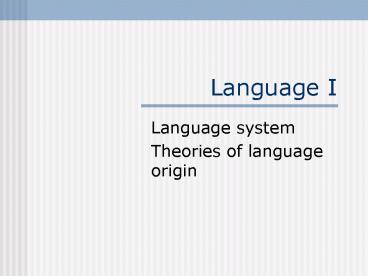Language I - PowerPoint PPT Presentation
1 / 13
Title:
Language I
Description:
Monkeys are capable of naming but they do not want to: no 'naming ... ( sea chanteys) theory) Grammar ('rabbit out of a hat', 'snail on the wall','bonfire' ... – PowerPoint PPT presentation
Number of Views:24
Avg rating:3.0/5.0
Title: Language I
1
Language I
- Language system
- Theories of language origin
2
- Language specific to our species?
- Communication systems in other species
- Bees, Birds Apes
- Language in Homo sapiens sapiens (protolanguage
and natural language)
3
Communication in bees
"Each bee on her return is followed by three or
four companions . . . how they do it has not yet
been observed" Aristotle, Historia Animalium,
IX
- Bees dance symbolization of the direction and
distance of flowers from the hive - dancing around (round dance)
- tail wagging dance
- No learning...
- A very limited repertoir
- Bees do not have in their language expression
up. There are no flowers in the sky - von Frisch, 1954
4
Birds
- Singing
- Young birds learn from adult birds
- Dialects within species
- Learning, critical period
- Babbling phase (pre-singing)
- Brain control left hemisphere
- What maters is the phrase, not separate sounds
5
- But
- Only male birds sing
- Specific function of singing
- Talking parrots
- Imitation of speech sounds
- Reactive use of several hndreds of words
- Nkisis case
6
Parrot's oratory stuns scientists By Alex Kirby
BBC News Online environment correspondent N'kisi'
s remarkable abilities, which are said to include
telepathy, feature in the latest BBC Wildlife
Magazine. N'kisi is believed to be one of the
most advanced users of human language in the
animal world. The bird, a captive African grey
called N'kisi, has a vocabulary of 950 words, and
shows signs of a sense of humour.
7
Geoffrey Pullum, University of California Language
Log, 01.2004
"PARROT'S ORATORY STUNS SCIENTISTS" burbles
Kirby's headline. The scientists would have to be
stunned to accept this slop. I am prepared to
voice doubt that there has ever been an example
anywhere of a non-human expressing a single
opinion, or even asking a question, ever. Here is
what would convince me N'kisi drops some fecal
matter into the water dish while sitting above
it, looks down, and says "Oh, dear, I pooped in
my drinking water" (without having been carefully
trained to do so, of course). Even Alex Kirby
goes way beyond any non-human animal or bird in
his linguistic capacities.
8
Apes
- A common ancestor of humans and chimpanzees 6
mln years ago. Beginings of hemispheric assymetry - Rich vocalization system in their natural
environment - Vervet monkeys Different vocalization to warn
others of snake, hawk or lampart - Raised by humans
- Taught human speech (Vicky, 1933)
- Taught a form of sign language
9
- Chimpanzee Washoe (Gardner Gardner), 350 words
(like most 3-yer-old children), spontaneous
naming (?) - Gorilla Koko (650 signs)
- Nim Chimpsky (Terrace, 1980), knew many signs,
used them together, but his sentences looked
like this - give orange me give eat orange me eat orange
give me eat orange give me you - No clear structure (grammar)
- No teaching/learning parent -gt children
- Instrumental use of signs
- Monkeys are capable of naming but they do not
want to no naming instinct (Aitchison)
10
- Aitchison, 2002 Naming is for primates what
swinging in the trees is for humans. People
sometimes do this, but most often most of them
does not feel like doing it.
11
Human natural language
- Language characteristics according to Hockett
- Duality of patterning a large number of
meaningful elements are made up of a conveniently
small number of meaningless but
message-differentiating elements (phonemes ?
words) - Productivity users can create and understand
completely novel messages - Arbitrariness there is no logical connection
between the form of the signal and its meaning
12
- Interchangeability of hearer/speaker roles
- Weak specialization a flexible connection
between a sign and reaction - Displacement linguistic messages may refer to
things remote in time and space - Cultural transmission the conventions of a
language are learned by interacting with more
experienced users. - Chomsky hierarchy possible transformations
depend on a hierarchical structure
13
Theories of language origin
- The Society does not accept papers on either the
origin of language or the invention of a
universal language. - founding statutes of the Linguistic Society
of Paris, 1866 - Protolanguage bow-wow theory, Oh! theory i
yo-he-ho! (sea chanteys) theory) - Grammar (rabbit out of a hat, snail on the
wall,bonfire) - Cognitive bases of language evolution































